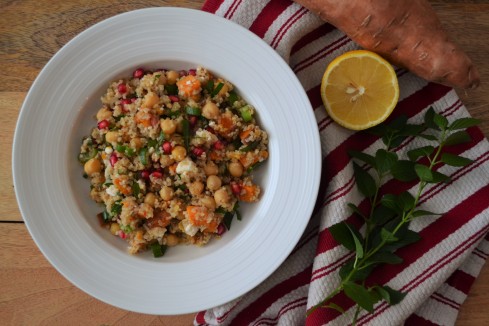In some circles, carbs have a really bad rap. I can’t count the number of times someone has told me they’ve cut out “all carbs” from their diet for weight loss (only to then learn that they’re still eating fruit, vegetables and dairy. NEWS ALERT: those foods contain carbs, too).
Let’s investigate some of the arguments against carbs that I’ve heard.

“Carbs will make me gain weight” or “I lost 10 pounds in one week when I cut starch from my diet.” Sorry honey, that weight you lost was all water. Study after study has shown that weight loss is equivalent in subjects following a low-fat diet vs. a low carb-diet vs. a high protein diet, assuming the same number of calories are consumed. Carbohydrate contains 4 calories per gram, which is the same as protein and significantly less than fat which clocks in at 9 calories per gram. A balance of all three makes up a healthy diet— more precisely, 10-35% of your calories should come from protein, 20-35% from fat, and 45-65% of your total caloric intake should come from carbohydrate. A major imbalance in these ratios can increase your risk of chronic disease and negatively impact micronutrient status.
“Eating carbs will give me diabetes.” This is probably the #1 diabetes myth. When carbohydrate is consumed, it’s naturally broken down by the body into a type of sugar called glucose. Insulin is then released so that your body can use glucose as a source of energy. Diabetes happens when the body doesn’t produce enough insulin or is unable to use insulin properly. Major risk factors for diabetes are genetic predisposition, older age, being overweight, and inactivity. If you don’t have risk factors for diabetes, your pancreas will be able to handle a significant glucose load without any problem. On the other hand, eating too many calories from carbs can cause weight gain which puts you at risk for developing diabetes. But that’s a completely different story.
“Grains have toxins that bind good nutrients in other foods, making them unabsorbable.” Every Paleo fanatic will tell you this, but they fail to disclose all relevant details. Grains are rich in many nutrients: B vitamins like niacin and thiamin, magnesium, manganese, and selenium. Grains also contain phytates, which can bind some minerals (particularly iron and zinc), making them unavailable for absorption. Paleo subscribers state that humans who eat grains are at risk of nutrient deficiencies because of the “anti-nutrient” phytate. What they fail to disclose is that heme iron absorption (the kind we get from meat) is not affected by phytate, and zinc is well-absorbed from meat even in the presence of phytates. So if you eat meat, you don’t need to worry about phytates impacting your micronutrient status. Paleo dieters also fail to tell you that phytate has health benefits: it acts as an antioxidant and may protect against kidney stones and decrease cancer risk.
Lectin is another “anti-nutrient” that Paleo followers caution against. I won’t get into the details here, but this article summarizes the evidence nicely: https://authoritynutrition.com/dietary-lectins/

In my opinion, the most valid argument against carbohydrates is that they’re easy to overeat. And this can lead to weight gain. A standard 1/2 cup serving of pasta or rice seems measly on your plate, so many people end up doling out portions more consistent with what they’ve become accustomed to at their favourite restaurants. Stick to reasonable portions and carbs become part of a healthy diet.
The benefits of carbohydrates extend beyond their nutritional profile. A low-carb diet can be taxing on the environment if calories from carbs are replaced with animal protein. And carbohydrate ingestion leads to the production of serotonin which is a feel-good neurotransmitter that gives us pleasure. If you’ve spent any length of time with a no-carb dieter, you will know that they can become irritable and cranky at the drop of a hat. No fun.
In honour of today’s carb-loving rant, I present you with a salad that is full of healthy carbs: bulgur, sweet potato, chickpeas, and pomegranate. My sister made this salad for our parents’ retirement party in the spring and it was a hit. Salty feta cheese is balanced nicely with refreshing mint and sweet, juicy pomegranate (which adds incredible texture to any dish). You really can’t go wrong with these flavours.
It’s carberific.

Happy Retirement Mom and Dad!

Chickpea Bulgur Salad with Mint, Pomegranate, and Feta
(adapted from an original recipe created by J’s friend SF)
If you’ve never de-seeded a pomegranate, it’s easier than it seems! This video shows you how to do it like a pro: http://bit.ly/2cxE35T
¾ cup uncooked bulgur
1½ cups low-sodium vegetable broth
1 can (19 oz) chickpeas, drained and rinsed
1 large sweet potato, chopped into bite-sized cubes
1 pomegranate, de-seeded
3-4 green onions, thinly sliced
1/2 cup crumbled feta cheese
1/3 cup chopped mint (or to taste)
Juice from 1/2 lemon (approx. 2 tbsp)
2 tbsp olive oil, divided
1/8 tsp salt
Freshly ground pepper, to taste
Additional salt, to taste
- Preheat oven to 375 degrees Fahrenheit. On a baking sheet, toss chopped sweet potato with 1 tbsp olive oil and 1/8 tsp salt. Bake until soft (approximately 30 minutes), stirring once partway through.
- Combine bulgur and vegetable stock in a medium pot and bring to a boil. Turn down to a simmer and cover until all liquid is absorbed (approximately 20 minutes).
- Once cooked, let the bulgur and sweet potato cool to room temperature in a bowl.
- Add chickpeas, pomegranate seeds, green onions, feta and mint to the bowl of cooled bulgur and sweet potato.
- In a small bowl, combine lemon juice and 1 tbsp olive oil. Add dressing to salad. Season with pepper (and salt, if needed) to taste.
- Keep refrigerated until ready to serve. This salad tastes best if made a few hours (or the night) before. Use as a side, or over a bed of spinach as a meal.
Makes 8 servings. Per 1 cup serving: 225 kcal, 7.1 g fat (2.1 g saturated), 34 g carbohydrate, 6 g fibre, 6.8 g protein, 265 mg sodium









